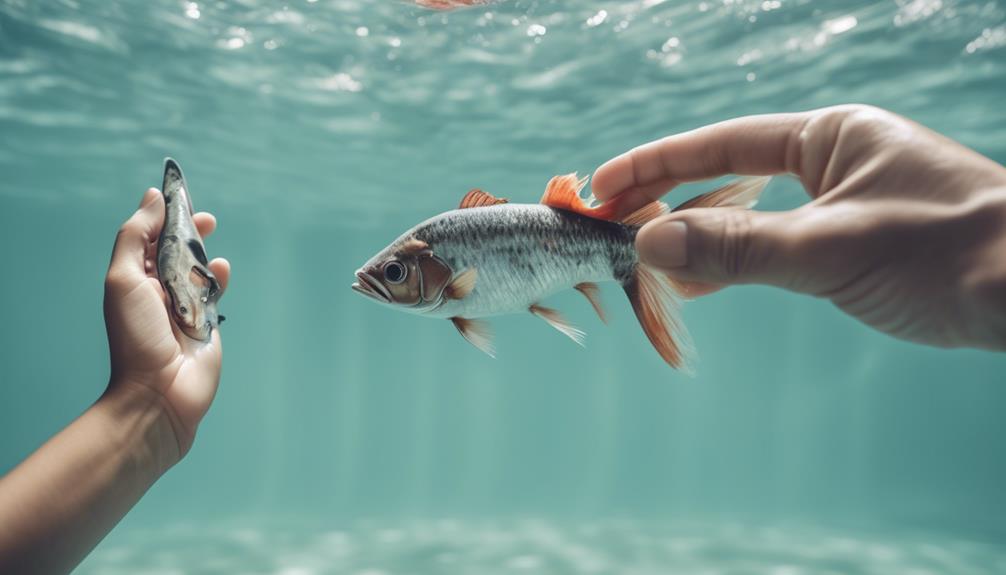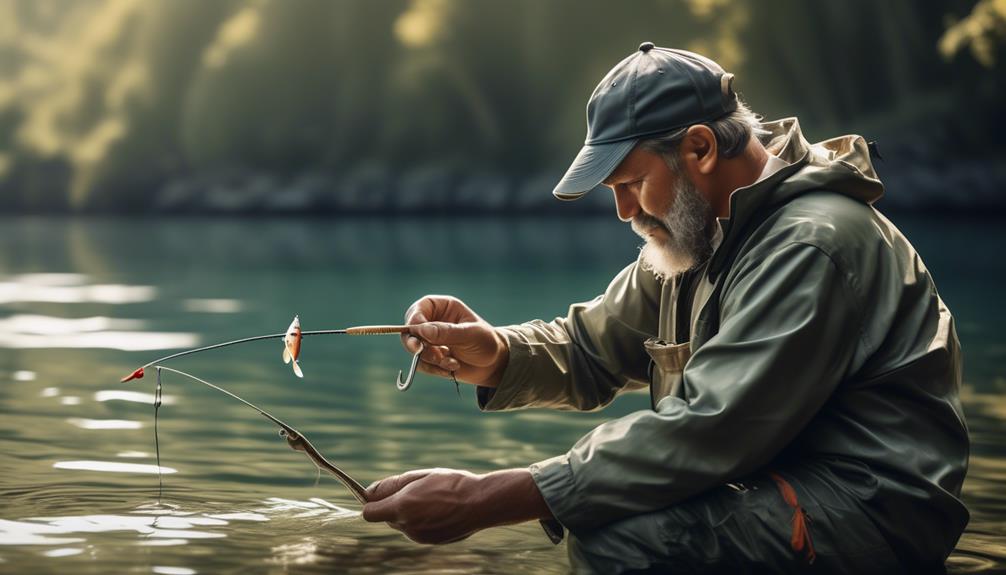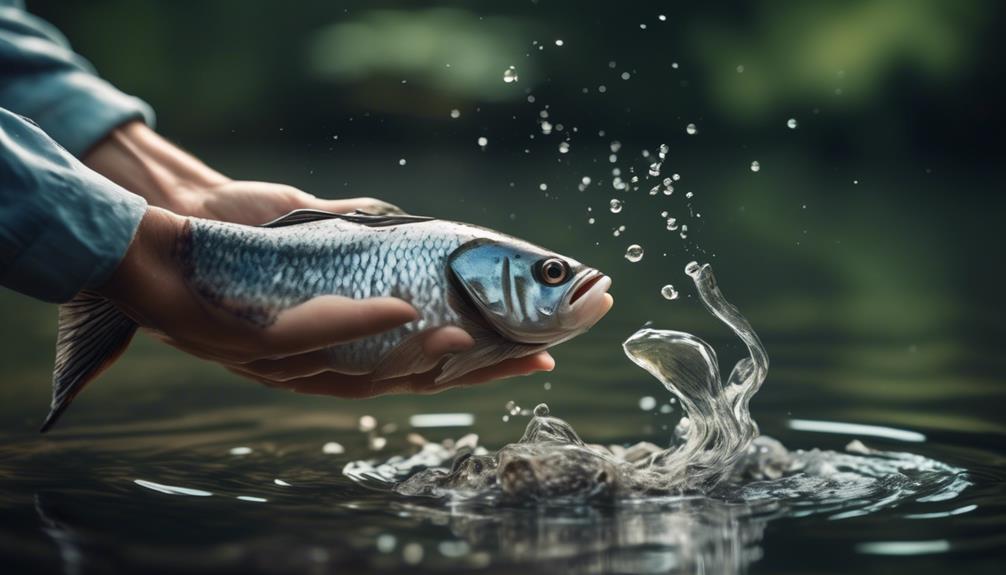So, you've just reeled in a magnificent catch, and now comes the crucial decision of what to do next. Ethical catch and release practices are increasingly important as we strive to preserve the delicate balance of marine ecosystems.
But how do you ensure that your catch survives and thrives after being released back into the wild? In this guide, we'll explore 13 essential tips for ethical catch and release worldwide, offering practical advice that will help you become a responsible angler and safeguard the future of our aquatic environments.
Understanding Catch and Release
Understanding catch and release involves carefully handling and returning caught fish to their natural habitat to ensure their survival. It's vital to grasp fish behavior to improve your catch and release technique. When you understand how fish behave, you can minimize the time they spend out of water and reduce their stress.
For instance, knowing that some fish are more likely to take the bait and swim towards deeper waters can help you avoid exhausting them during the catch. This understanding can significantly impact conservation efforts as well. By releasing fish unharmed, you contribute to the preservation of fish populations and their ecosystems. It's a simple act that can have a substantial positive effect on the environment.
Conservation impact is a crucial aspect of catch and release. Many anglers practice catch and release to ensure that fish populations remain healthy and sustainable. By understanding fish behavior, you can further enhance this impact.
For example, knowing the tendency of certain species to gather in specific areas during breeding seasons can help avoid disrupting their reproductive cycles. This knowledge allows anglers to avoid these areas during critical times, helping to maintain the natural balance of fish populations.
Proper Handling Techniques
To ensure the survival of caught fish and minimize their stress, master proper handling techniques during catch and release. Safeguarding fish is crucial for their well-being, and it begins with gentle and careful handling. When you land a fish, wet your hands before touching it. This helps to protect the fish's delicate mucous layer, which is vital for its protection against infections. Additionally, using barbless hooks can make hook removal easier and less damaging to the fish.
Minimizing stress on the fish is essential for its survival after release. Avoid lifting the fish by its gills or mouth, as this can cause internal injuries and harm its vital organs. Instead, support the fish gently by cradling it in the water, keeping it upright to ensure proper oxygen flow. When removing the hook, do it swiftly and carefully. For particularly stubborn hooks, consider using a specialized tool to minimize handling time.
It is also important to minimize air exposure. Hold your breath if you need to take a quick photo, and make sure to keep the fish in the water as much as possible. If you do need to handle the fish out of the water, keep it moist and try to limit the time out of its natural environment.
Selecting the Right Gear
When selecting the right gear for fishing, consider the specific species you'll be targeting and the fishing conditions you anticipate encountering. Gear selection plays a crucial role in minimizing the environmental impact of your fishing activities and ensuring ethical practices.
Firstly, it's important to familiarize yourself with the fishing regulations in the area you'll be fishing. Different regions have specific rules regarding the type and size of gear that can be used, as well as restrictions on certain fishing methods. Adhering to these regulations not only promotes ethical fishing but also helps in the conservation of fish populations.
Next, choose gear that's appropriate for the specific species you intend to catch. For example, if you're targeting larger fish, ensure that your gear is strong enough to reel them in without causing excessive stress or injury. Using the right gear can also help you avoid unintentionally hooking non-target species, reducing the likelihood of harm to them.
Additionally, consider the environmental impact of your gear. Opt for environmentally friendly materials and avoid lead-based products, which can be harmful to both fish and the environment.
Furthermore, consider the fishing conditions you expect to encounter. If you anticipate fishing in areas with heavy vegetation, choose gear that minimizes the chances of getting tangled or causing damage to underwater habitats.
Identifying Barotrauma Symptoms
If you're fishing in deep waters, be vigilant for signs of barotrauma in the fish you catch. Barotrauma occurs when fish are brought up from deep waters too quickly, causing a sudden change in pressure that can injure their swim bladders and internal organs. Recognizing signs of barotrauma is crucial for practicing ethical catch and release. Common symptoms include bulging eyes, stomach protrusion, and the presence of the stomach, intestines, or other internal organs protruding from the fish's mouth. Additionally, fish may display erratic swimming patterns or struggle to maintain their balance in the water.
Preventing barotrauma is essential to minimize harm to the fish. To prevent this condition, it's important to use descending devices, such as venting tools or weighted release tools, to help fish return to their natural depth. These tools allow fish to be safely released at the depth from which they were caught, reducing the risk of barotrauma. When caught in deep waters, consider using fish-friendly tackle, such as circle hooks, to minimize injury and increase the chances of survival upon release.
Recognizing signs of barotrauma is a critical aspect of ethical catch and release fishing. By being aware of these symptoms and taking preventive measures, you can minimize the impact of barotrauma on fish populations and contribute to sustainable angling practices.
Best Practices for Hook Removal
For safe and humane hook removal when catching and releasing fish, always have a sturdy pair of needle-nose pliers readily accessible. Proper hook removal is crucial in preventing injury to the fish and minimizing stress on its body.
When handling a hooked fish, ensure that it remains in the water to support its weight and reduce the risk of injury. Use the needle-nose pliers to firmly grip the hook and carefully back it out in the opposite direction it entered. If the fish swallows the hook, it's best to cut the line as close to the hook as possible rather than attempting to remove it, as this can cause more harm.
It's important to work efficiently but gently, as the longer the fish is out of the water, the greater the stress and potential harm. If the hook is deeply embedded, consider seeking the assistance of a professional or experienced angler to minimize the time the fish spends out of the water.
After successful hook removal, gently release the fish back into the water, supporting it until it swims away on its own.
Considerations for Fish Fighting Time
To minimize stress on the fish and ensure its well-being during hook removal, it's important to also consider the duration of the fishing battle and its potential impact on the fish's health. Reducing stress on the fish during the fight is crucial for successful catch and release. Prolonged fights can exhaust the fish, leading to increased lactic acid build-up and physical exertion, which may decrease its chances of survival after release. Conservation efforts rely on the ethical treatment of fish during catch and release, making it essential to minimize the duration of the fight.
When engaging in catch and release fishing, it's vital to use appropriate tackle and gear to reduce the fighting time. Opt for the right fishing line weight and rod strength to efficiently reel in the fish without subjecting it to an unnecessarily prolonged struggle. Additionally, maintaining steady pressure on the fish while reeling it in can help shorten the fighting time, as opposed to allowing the fish to make long, drawn-out runs.
Moreover, it's essential to handle the fish with care and efficiency once it's hooked, as this can significantly impact the overall duration of the fight. By promptly and skillfully maneuvering the fish towards the boat or shore, anglers can reduce the stress on the fish and maximize its chances of survival after release.
Preparing for Safe Release

Ensure that the fish is properly supported and handled to minimize any potential injury or stress before releasing it back into the water. Once you've successfully landed the fish, it's important to prepare for its safe release.
Here are some key considerations to ensure the fish's well-being:
- Release location: Choose a release location with calm waters and minimal current to allow the fish to regain its strength before swimming off.
- Release timing: Time your release carefully, aiming to do so during periods of low fishing activity to reduce the risk of the fish being caught again immediately.
- Handle with care: Minimize the time the fish is out of the water, and avoid removing the protective slime layer by wetting your hands before handling the fish.
- Reviving the fish: If the fish appears exhausted, hold it upright underwater, allowing water to flow through its gills until it shows signs of readiness to swim away.
- Monitoring the fish: Observe the fish as it swims away to ensure it recovers fully and isn't in distress.
Monitoring Post-Release Behavior
After preparing the fish for safe release, it's important to monitor its post-release behavior to ensure its well-being. Behavior monitoring is a crucial step in ethical catch and release practices. Once the fish is back in the water, take a moment to observe how it swims away. Ideally, the fish should swim off energetically, indicating that it has recovered from the stress of being caught.
If the fish appears sluggish or disoriented, gently support it in the water until it shows signs of readiness to swim away on its own. In some cases, it may be necessary to provide additional assistance to the fish. If the fish is struggling to swim or remains motionless, gently move it back and forth in the water to help oxygen flow through its gills. Avoid handling the fish excessively, as this can remove its protective slime coat and potentially harm it. Continuously monitor the fish until it's able to swim away under its own power.
Remember that ethical practices don't end once the fish is released. Consider staying in the area for a little while to ensure that the fish fully recovers. By monitoring the post-release behavior of the fish, you can play a key role in promoting the well-being of the fish population in the waters you love to fish.
Frequently Asked Questions
What Are the Legal Requirements for Catch and Release Fishing in Different Countries?
Legal requirements for catch and release fishing vary by country, reflecting conservation efforts and addressing the global regulations to minimize environmental impact.
Research the specific rules and regulations for the area where you plan to fish. In many places, you may need a fishing license or permit, and there may be restrictions on the size and number of fish you can catch and release.
Always respect the local laws and conservation efforts.
Are There Any Specific Techniques for Catching and Releasing Different Species of Fish?
When catching and releasing different species of fish, it's important to use species-specific techniques for ethical handling. This helps ensure sustainable practices and minimizes environmental impact.
Avoid common misconceptions and increase awareness about the proper way to release each species. By using the right techniques, you can contribute to the conservation of fish populations and their habitats, promoting a healthier and more balanced aquatic ecosystem.
How Can Anglers Ensure That Their Fishing Practices Are Not Harming the Environment or Local Ecosystems?
To minimize the environmental impact of your fishing practices, make sure to follow local fishing regulations and use proper gear to avoid harming non-targeted species.
Always handle fish with care and release them gently. Consider using barbless hooks and avoid overfishing in sensitive areas.
Are There Any Alternative Methods for Catch and Release That May Be More Ethical or Sustainable?
To ensure sustainable practices, consider alternative methods for catch and release. Ethical considerations and conservation efforts are essential.
Look into using circle hooks, barbless hooks, or single hooks to reduce harm to fish. Minimize air exposure, handle fish gently, and release them in calm waters. Avoid deep-hooked fish, and use proper gear to avoid injury.
These practices can help promote ethical and sustainable catch and release methods.
What Are Some Common Misconceptions About Catch and Release Fishing That Anglers Should Be Aware Of?
Common misconceptions about catch and release fishing can have a significant environmental impact. It's crucial for anglers to understand their responsibility in practicing ethical catch and release methods.
Some misconceptions include thinking that fish always survive after being released, or that hook injuries are insignificant. Understanding these misconceptions can help anglers make more informed decisions and adopt more ethical practices when engaging in catch and release fishing.
Conclusion
Overall, practicing ethical catch and release is crucial for the conservation of fish populations worldwide.
By understanding proper handling techniques, using the right gear, and being mindful of fish fighting time, you can ensure the safe release and survival of the fish you catch.
By following these tips, you can enjoy the sport of fishing while also contributing to the sustainability of aquatic ecosystems.



